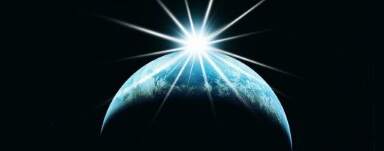
This is the most paramount time in the liturgical calendar. The season of Lent has led us to Holy Week. Holy Week has overlapped our time with Jesus’ last week of ministry in Jerusalem, bringing us to the night he broke bread, washed feet, and was betrayed, and finally to Friday, the day he was murdered. In order to make present the day, events, and sorrow of Jesus’ execution, Trinity held a Good Friday service with somber songs and scripture readings yesterday. The focal scripture was from the book St. John wrote. His account shows us not only specific events in a place and a time, but also the fulfillment of a story that began…in the beginning.
John began his book with the words “In the beginning.” This was no accident, and his point was made loud and clear – the context of this story begins at Genesis. The narrative is that of Creation. We learn that Jesus, the center of John’s story, is also supposed to be the center of all creation – of all that is, was, or ever will be. It’s within that context that we have to look at Jesus’ words and miracles. John’s gospel climbs up to Holy Week, which begins on a Sunday, the first day of the week. Holding in our heads the story of creation, we come to Friday, the sixth day, when God made man to bear His image and rule over the world. Of course we know that mankind failed at the task of image bearing and ruling. But here is Jesus, the new focus of creation, the new Man. And so we have Pilate’s words on Friday, “Here is the man,” unwittingly enacting this drama the second time around. Behold, this time though, we have the perfect example of humanity. We have him, and we put him to death.
Then we come to Saturday. “And on the seventh day he rested.” John calls him the Light of the world, and he was extinguished and hidden in a tomb. What a mystery. All of creation saw its champion killed and buried. The cosmos mourned in darkness. Seven days had passed, and the narrative of creation was over. Was that the end? If so, we would have no hope at all. But thanks be to God.
Very early on “the first day of the week” (John 20:1), something happened. A few verses later (John 20:19), John says it again – a new “first day of the week” had come. What happened on the very first “first day of the week?” Creation was begun. John is telling us here that a new creation has begun! Jesus was not only raised from the dead (like he had done for Lazarus), but he had defeated death. The curse of death that had corrupted creation was defeated in its first measure with the Resurrection of Jesus. It will be fully defeated on the day God completes the New Creation. The New Creation means no more curse. It’s NEW creation. It’s the point of the whole story. It’s what God was always going to accomplish. It’s the vindication of God’s original creation, now transformed into what it was always meant to become. And we’re meant to be transformed too. Jesus was the first to be resurrected, and we will eventually follow suit along with the entire cosmos (Col 1:17-20).
Resurrection Sunday – Easter – is the most important day memorialized by the Church. The implications of Easter, however, are far too big to fit into one day. That’s why the Easter season (the 7 weeks between Easter and Pentecost) is so appropriate. Easter means resurrection. Resurrection means the transformation of what was dead to new life. New life is new creation, and new heavens and new earth (Rev 21:1-5). But if new creation began with Jesus’ resurrection, what does that mean about the time between then and now? It means God is allowing us to put into practice the new order of things that Jesus initiated on Easter day. We have intermediate work to do. We are working for the new creation with the promise that our work won’t be wasted (1 Cor 3:11-14). And neither will this current creation be wasted (Rom 8:19-22). So don’t write off the physical creation, this world or your body. Instead, think about how to anticipate what the New Creation will be like by treating this creation as if it belongs to it. Use this Easter season to work that out, all the while celebrating the fact that Jesus is already our first example of the transformative power of God to renew His beloved creation.
